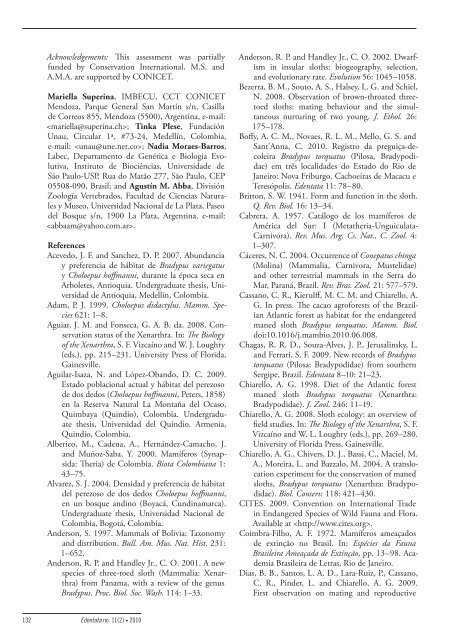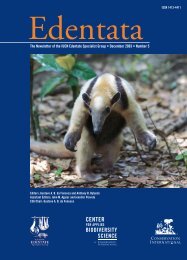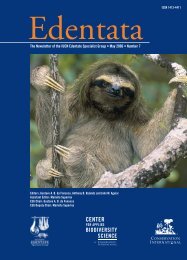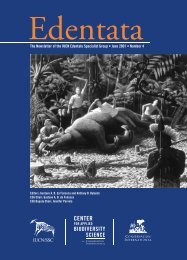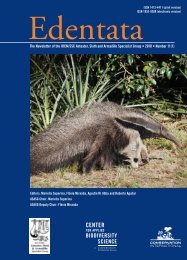Edentata 11(2), 2010 - Anteater, Sloth & Armadillo Specialist Group
Edentata 11(2), 2010 - Anteater, Sloth & Armadillo Specialist Group
Edentata 11(2), 2010 - Anteater, Sloth & Armadillo Specialist Group
- No tags were found...
You also want an ePaper? Increase the reach of your titles
YUMPU automatically turns print PDFs into web optimized ePapers that Google loves.
Acknowledgements: This assessment was partiallyfunded by Conservation International. M.S. andA.M.A. are supported by CONICET.Mariella Superina, IMBECU, CCT CONICETMendoza, Parque General San Martín s/n, Casillade Correos 855, Mendoza (5500), Argentina, e-mail:; Tinka Plese, FundaciónUnau, Circular 1ª, #73-24, Medellín, Colombia,e-mail: ; Nadia Moraes-Barros,Labec, Departamento de Genética e Biologia Evolutiva,Instituto de Biociências, Universidade deSão Paulo-USP, Rua do Matão 277, São Paulo, CEP05508-090, Brasil; and Agustín M. Abba, DivisiónZoología Vertebrados, Facultad de Ciencias Naturalesy Museo, Universidad Nacional de La Plata, Paseodel Bosque s/n, 1900 La Plata, Argentina, e-mail:.ReferencesAcevedo, J. F. and Sanchez, D. P. 2007. Abundanciay preferencia de hábitat de Bradypus variegatusy Choloepus hoffmanni, durante la época seca enArboletes, Antioquia. Undergraduate thesis, Universidadde Antioquia, Medellín, Colombia.Adam, P. J. 1999. Choloepus didactylus. Mamm. Species621: 1–8.Aguiar, J. M. and Fonseca, G. A. B. da. 2008. Conservationstatus of the Xenarthra. In: The Biologyof the Xenarthra, S. F. Vizcaíno and W. J. Loughry(eds.), pp. 215–231. University Press of Florida,Gainesville.Aguilar-Isaza, N. and López-Obando, D. C. 2009.Estado poblacional actual y hábitat del perezosode dos dedos (Choloepus hoffmanni, Peters, 1858)en la Reserva Natural La Montaña del Ocaso,Quimbaya (Quindío), Colombia. Undergraduatethesis, Universidad del Quindio. Armenia,Quindío, Colombia.Alberico, M., Cadena, A., Hernández-Camacho, J.and Muñoz-Saba, Y. 2000. Mamíferos (Synapsida:Theria) de Colombia. Biota Colombiana 1:43–75.Alvarez, S. J. 2004. Densidad y preferencia de hábitatdel perezoso de dos dedos Choloepus hoffmanni,en un bosque andino (Boyacá, Cundinamarca).Undergraduate thesis, Universidad Nacional deColombia, Bogotá, Colombia.Anderson, S. 1997. Mammals of Bolivia: Taxonomyand distribution. Bull. Am. Mus. Nat. Hist. 231:1–652.Anderson, R. P. and Handley Jr., C. O. 2001. A newspecies of three-toed sloth (Mammalia: Xenarthra)from Panama, with a review of the genusBradypus. Proc. Biol. Soc. Wash. <strong>11</strong>4: 1–33.Anderson, R. P. and Handley Jr., C. O. 2002. Dwarfismin insular sloths: biogeography, selection,and evolutionary rate. Evolution 56: 1045–1058.Bezerra, B. M., Souto, A. S., Halsey, L. G. and Schiel,N. 2008. Observation of brown-throated threetoedsloths: mating behaviour and the simultaneousnurturing of two young. J. Ethol. 26:175–178.Boffy, A. C. M., Novaes, R. L. M., Mello, G. S. andSant’Anna, C. <strong>2010</strong>. Registro da preguiça-decoleiraBradypus torquatus (Pilosa, Bradypodidae)em três localidades do Estado do Rio deJaneiro: Nova Friburgo, Cachoeiras de Macacu eTeresópolis. <strong>Edentata</strong> <strong>11</strong>: 78–80.Britton, S. W. 1941. Form and function in the sloth.Q. Rev. Biol. 16: 13–34.Cabrera, A. 1957. Catálogo de los mamíferos deAmérica del Sur: I (Metatheria-Unguiculata-Carnivora). Rev. Mus. Arg. Cs. Nat., C. Zool. 4:1–307.Cáceres, N. C. 2004. Occurrence of Conepatus chinga(Molina) (Mammalia, Carnivora, Mustelidae)and other terrestrial mammals in the Serra doMar, Paraná, Brazil. Rev. Bras. Zool. 21: 577–579.Cassano, C. R., Kierulff, M. C. M. and Chiarello, A.G. In press. The cacao agroforests of the BrazilianAtlantic forest as habitat for the endangeredmaned sloth Bradypus torquatus. Mamm. Biol.doi:10.1016/j.mambio.<strong>2010</strong>.06.008.Chagas, R. R. D., Souza-Alves, J. P., Jerusalinsky, L.and Ferrari, S. F. 2009. New records of Bradypustorquatus (Pilosa: Bradypodidae) from southernSergipe, Brazil. <strong>Edentata</strong> 8–10: 21–23.Chiarello, A. G. 1998. Diet of the Atlantic forestmaned sloth Bradypus torquatus (Xenarthra:Bradypodidae). J. Zool. 246: <strong>11</strong>–19.Chiarello, A. G. 2008. <strong>Sloth</strong> ecology: an overview offield studies. In: The Biology of the Xenarthra, S. F.Vizcaíno and W. L. Loughry (eds.), pp. 269–280.University of Florida Press, Gainesville.Chiarello, A. G., Chivers, D. J., Bassi, C., Maciel, M.A., Moreira, L. and Bazzalo, M. 2004. A translocationexperiment for the conservation of manedsloths, Bradypus torquatus (Xenarthra: Bradypodidae).Biol. Conserv. <strong>11</strong>8: 421–430.CITES. 2009. Convention on International Tradein Endangered Species of Wild Fauna and Flora.Available at .Coimbra-Filho, A. F. 1972. Mamíferos ameaçadosde extinção no Brasil. In: Espécies da FaunaBrasileira Ameaçada de Extinção, pp. 13–98. AcademiaBrasileira de Letras, Rio de Janeiro.Dias, B. B., Santos, L. A. D., Lara-Ruiz, P., Cassano,C. R., Pinder, L. and Chiarello, A. G. 2009.First observation on mating and reproductive132<strong>Edentata</strong> no. <strong>11</strong>(2) • <strong>2010</strong>


